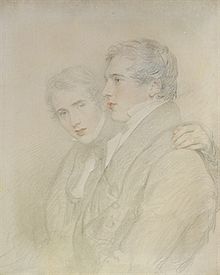Andrew Bloxam
| Andrew Bloxam | |
|---|---|

Portrait of Andrew Bloxam and Richard Rowland Bloxam by their uncle Sir Thomas Lawrence, prior to their voyage in 1824
|
|
| Born |
September 22, 1801 Rugby, Warwickshire, England |
| Died | February 2, 1878 (aged 76) Harborough Magna, Warwickshire, England |
| Nationality | British |
| Fields | Natural history, Mycology, Botany |
| Known for | Voyage to Hawaii; contributions to natural history, especially fungi and the genera Rosa and Rubus. |
| Author abbrev. (botany) | A.Bloxam |
Andrew Bloxam (22 September 1801 – 2 February 1878) was an English clergyman and naturalist; in his later life he had a particular interest in botany. He was the naturalist on board HMS Blonde during its voyage around South America and the Pacific in 1824–26, where he collected mainly birds. Later as a Church of England minister he lived in Warwickshire and Leicestershire and made significant contributions to the study of the natural history of the area. His special interest was in fungi and the genera Rubus and Rosa. His botanical author abbreviation is "A.Bloxam".
Andrew Bloxam was born at Rugby, Warwickshire, on 22 September 1801. He was the fourth son of Rev. Richard Rouse Bloxam, who was a schoolmaster at Rugby School, and Ann(e) Lawrence, who was the sister of the painter Sir Thomas Lawrence. He was educated at Rugby School from 1809 and Worcester College, Oxford from 1820.
In the autumn of 1824, he was appointed as a naturalist on board HMS Blonde, commanded by Capt. Lord Byron, cousin of the poet George Gordon Byron. His brother, R. Rowland Bloxam (1798–1877), was the chaplain. The voyage lasted over 18 months, during which time he visited South America and various islands of the Pacific, including the Galápagos Islands and the Hawaiian Islands (then called the Sandwich Islands). Most of Bloxam's collections during the voyage eventually found their way to the British Museum.
After returning from the voyage on 15 March 1826, he was ordained on 25 June 1826 (Trinity Sunday) as a Church of England minister. He spent some time in Leicestershire and as a curate in Atherstone, before he became the Vicar of Twycross (c. 1840). He remained there until c. 1872, when he was made Vicar of Radford Semele and shortly afterwards Rector of Harborough Magna, where he died on 2 February 1878. He was married to Ann(e) Roby.
...
Wikipedia
